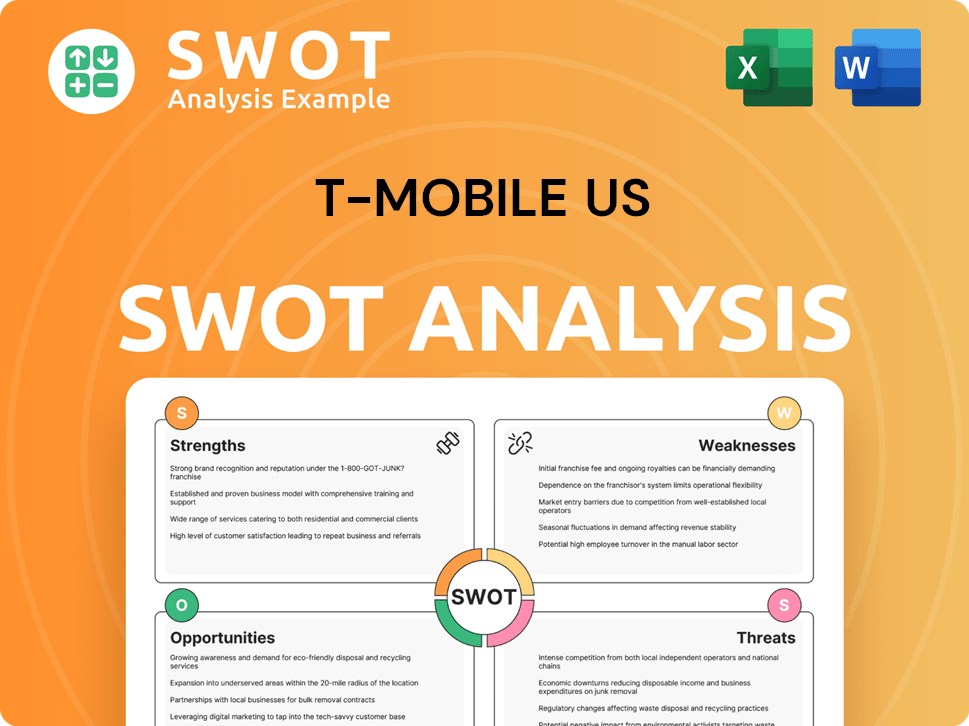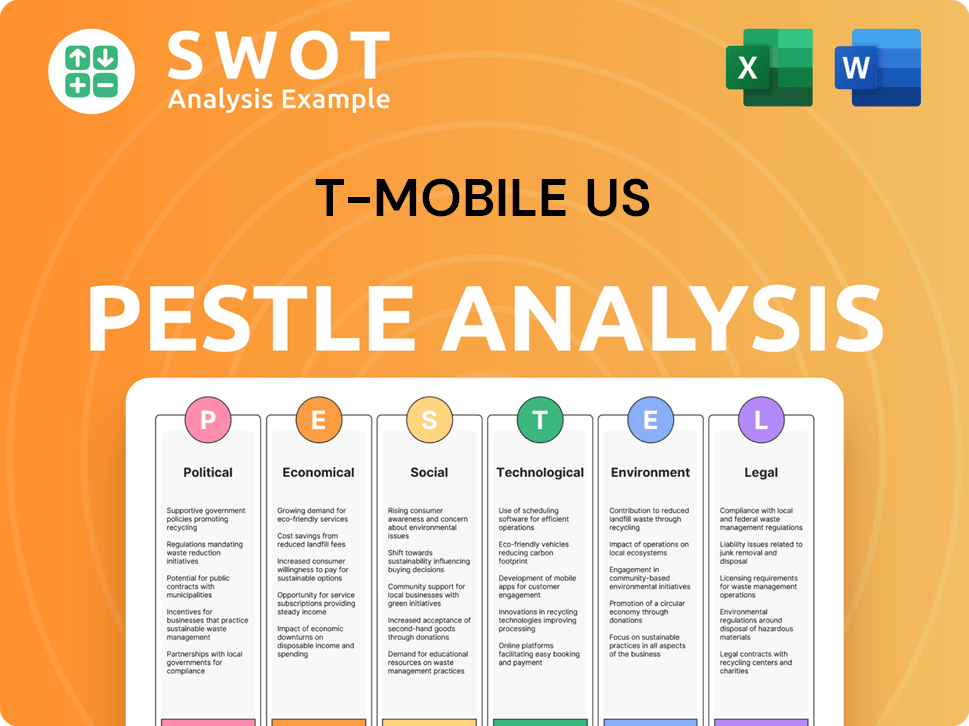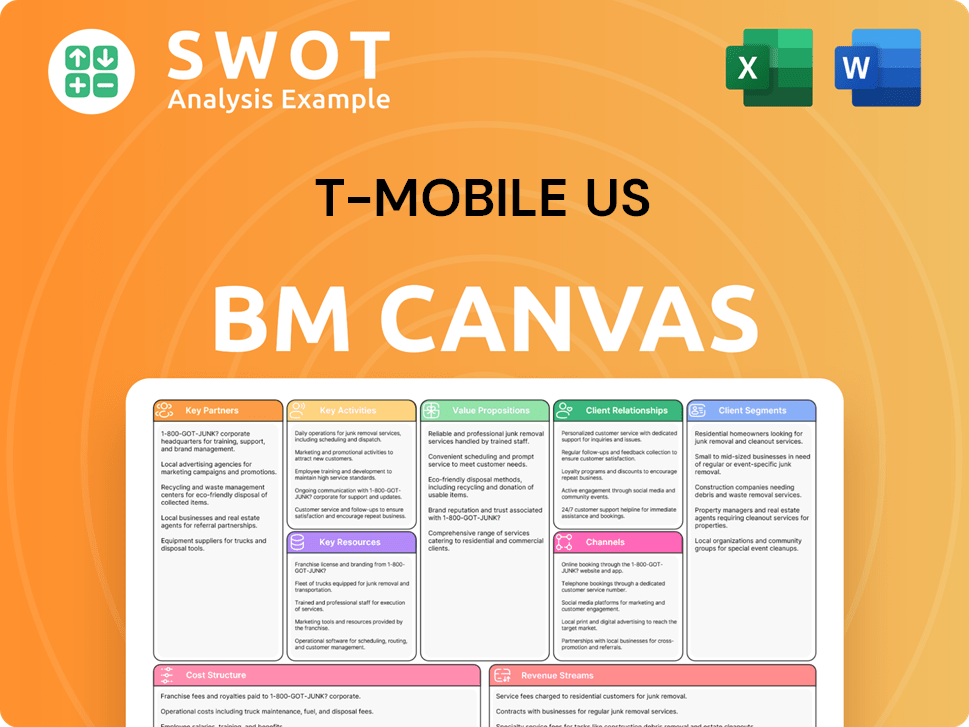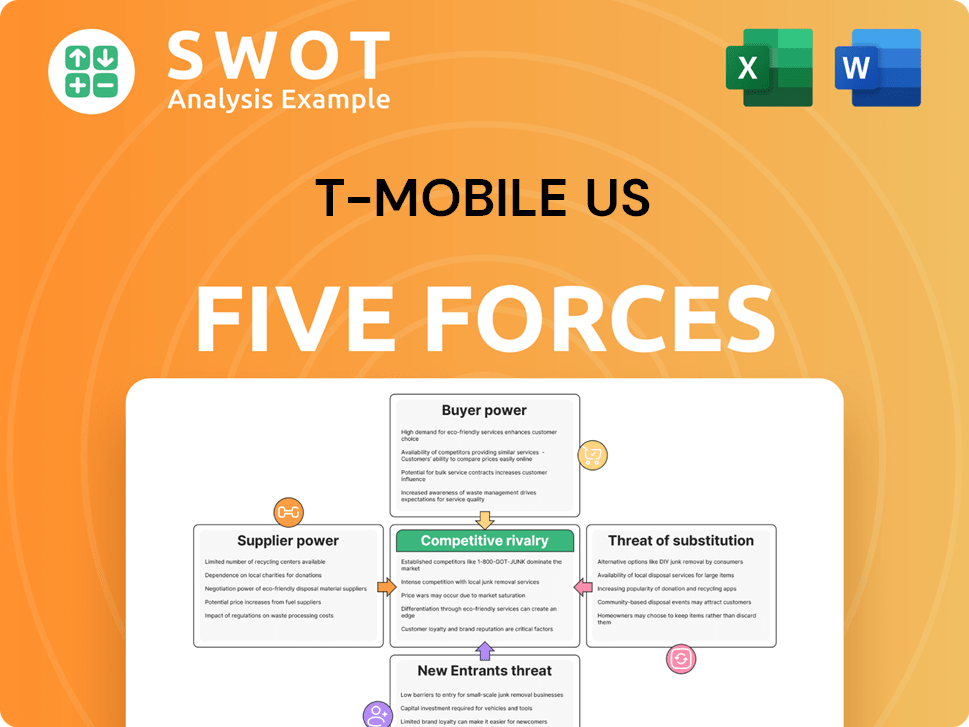T-Mobile US Bundle
How Did T-Mobile Disrupt the Telecom Industry?
T-Mobile US, Inc. isn't just a wireless carrier; it's a market disrupter. Its "Un-carrier" strategy revolutionized the industry, challenging the status quo with customer-centric policies and innovative marketing. This shift propelled T-Mobile to the forefront, but how did they achieve such remarkable growth and brand loyalty?

This deep dive into T-Mobile US SWOT Analysis will explore its sales and marketing strategies, from its pioneering "Un-carrier" movement to its current market dominance. We'll uncover the tactics behind its impressive customer acquisition, dissect its competitive analysis, and examine the key T-Mobile marketing campaigns that have fueled its success. Learn how T-Mobile's focus on customer retention programs and strategic partnerships has solidified its position in the ever-evolving telecom landscape, including its digital marketing and social media marketing tactics.
How Does T-Mobile US Reach Its Customers?
The sales channels of T-Mobile US are a key component of its overall T-Mobile US sales strategy, employing a mix of online and offline methods to reach a broad customer base. These channels include the company's website and e-commerce platforms, physical retail locations, direct sales teams, and strategic partnerships. This multi-channel approach allows T-Mobile to engage with customers in various ways, catering to different preferences and needs.
The evolution of these sales channels reflects T-Mobile's strategic shifts, particularly its 'Un-carrier' approach, which focuses on simplifying offerings and enhancing customer experience. The company has increasingly embraced digital adoption, with its website and e-commerce platforms playing a vital role in customer acquisition and service management. The company's own branded stores also remain crucial physical touchpoints, providing direct customer interaction and personalized service.
Strategic partnerships and acquisitions have significantly contributed to T-Mobile's growth and market share. The acquisition of Sprint in 2020 reduced the number of major players in the mobile market, allowing T-Mobile to expand its network coverage, especially with 5G technology. Furthermore, T-Mobile continues to expand its broadband footprint through fiber partnerships, aiming to serve a large number of households by 2030.
T-Mobile's physical retail locations are a crucial part of its sales strategy, providing direct customer interaction and service. In Q1 2024, the company increased its headcount, including retail employees, to support its growing customer base. This highlights the continued importance of its physical retail presence in customer acquisition and retention.
T-Mobile heavily utilizes digital channels, including its website and e-commerce platforms, for customer acquisition and service management. The mobile site is regularly updated to keep up with web design trends, offering a user-friendly experience. These digital platforms are essential for reaching a wide audience and providing convenient services.
Partnerships and acquisitions play a significant role in T-Mobile's growth. The Sprint acquisition expanded its network and market share. The recent agreement to acquire UScellular's mobile operations will further enhance its subscriber base and network coverage. These strategic moves are vital for expanding T-Mobile's reach.
T-Mobile provides wholesale wireless network access to mobile virtual network operators. As of Q2 2024, wholesale sales contributed approximately 5% of its annual revenue. The company is also expanding its broadband footprint through fiber partnerships, aiming to serve millions of households by 2030.
T-Mobile's sales strategy relies on a combination of physical retail, digital platforms, and strategic partnerships to drive growth and customer acquisition. The company's focus on enhancing customer experience and expanding its network coverage through strategic acquisitions and partnerships is a key aspect of its sales approach.
- Physical Retail: Branded stores for direct customer interaction and service.
- Digital Platforms: Website and e-commerce for customer acquisition and service.
- Strategic Partnerships: Acquisitions like Sprint and UScellular to expand market share.
- Wholesale and Broadband: Wholesale wireless access and fiber partnerships for revenue growth.
T-Mobile US SWOT Analysis
- Complete SWOT Breakdown
- Fully Customizable
- Editable in Excel & Word
- Professional Formatting
- Investor-Ready Format

What Marketing Tactics Does T-Mobile US Use?
The marketing tactics employed by T-Mobile US are multifaceted, designed to boost brand awareness and sales through a blend of digital and traditional methods. This approach targets a broad audience, including tech enthusiasts and those seeking affordable wireless plans. The company strategically uses various channels to reach its customers and maintain a competitive edge in the telecom market.
T-Mobile's strategy includes significant investments in digital marketing, leveraging content marketing, SEO, and social media. These efforts are complemented by traditional advertising, such as TV and radio campaigns. The company's focus on data-driven marketing and customer segmentation allows for personalized offers, enhancing customer engagement and loyalty.
The company's commitment to innovation is evident in its partnerships and investments in AI, aiming to improve network performance and customer service. This integrated approach ensures that T-Mobile remains competitive and responsive to market changes.
T-Mobile heavily utilizes digital marketing, including content marketing, SEO, and social media. These strategies are crucial for engaging its target audience and driving sales.
Influencer collaborations are a key element of T-Mobile's marketing mix. Recent campaigns have featured high-profile influencers to promote products and services.
Traditional media, such as TV and radio, remains a part of T-Mobile's marketing efforts, ensuring broad reach. The company uses these channels to promote its brand and offerings.
T-Mobile focuses on data-driven marketing to personalize promotions and offers. Customer segmentation allows for targeted campaigns, enhancing customer engagement.
The company is investing in AI to enhance its network and customer-driven coverage. These investments are designed to improve service and efficiency.
T-Mobile is expanding into advertising technology through acquisitions like Blis and Vistar Media. These moves are aimed at building out its T-Mobile Advertising Solutions (T-Ads) suite.
T-Mobile's marketing tactics are designed to maintain its competitive position in the telecom industry. The company's digital and traditional marketing efforts are supported by strategic partnerships and investments in technology. The company's focus on customer engagement and personalized offers helps drive sales and build brand loyalty. For a deeper dive into how T-Mobile is growing, consider reading about the Growth Strategy of T-Mobile US.
T-Mobile's marketing strategy includes a range of tactics to reach its target audience and drive sales. These initiatives are supported by significant investments and strategic partnerships.
- Digital Advertising: T-Mobile uses targeted ads on social media and search engines to increase brand awareness.
- Influencer Marketing: Collaborations with influencers like Kai Cenat and Snoop Dogg are used to promote products.
- Advertising Technology: The acquisition of Blis and Vistar Media expands T-Mobile's advertising solutions.
- Data-Driven Personalization: Customer segmentation and personalized offers enhance customer engagement.
- AI Integration: Investments in AI aim to improve network performance and customer service.
T-Mobile US PESTLE Analysis
- Covers All 6 PESTLE Categories
- No Research Needed – Save Hours of Work
- Built by Experts, Trusted by Consultants
- Instant Download, Ready to Use
- 100% Editable, Fully Customizable

How Is T-Mobile US Positioned in the Market?
The brand positioning of T-Mobile US centers on its 'Un-carrier' identity, a strategic move designed to disrupt the traditional mobile industry. This approach emphasizes eliminating contracts, simplifying pricing structures, and offering customer-centric perks. This core message is a key element of the Growth Strategy of T-Mobile US, aiming to reshape customer expectations and build a strong brand identity.
The visual identity of the brand is instantly recognizable, thanks to its distinctive magenta color. This, combined with a tone of voice that is often described as pioneering, provocative, confident, innovative, and straight-talking, creates a strong and recognizable presence. This approach helps differentiate from competitors like Verizon and AT&T.
T-Mobile differentiates itself by focusing on value, innovation, and a strong emphasis on customer experience. This strategy is designed to appeal to tech-savvy consumers, millennials, and individuals seeking affordable and reliable wireless communication services. The company's commitment to customer satisfaction is a key differentiator, with investments in employee training to deliver top-notch service and support across various channels.
T-Mobile's expansive and fast 5G network is a significant differentiator. As of 2024, its 5G network covers over 300 million people across the United States. This extensive coverage provides a competitive edge, particularly in underserved rural areas, enhancing its mobile network marketing.
Strategic investments in mid-band spectrum, especially from the Sprint acquisition, allow T-Mobile to offer faster speeds and broader coverage. This approach helps T-Mobile maintain its competitive edge. These investments are crucial for supporting its sales performance analysis.
Brand consistency is maintained across various channels and touchpoints, reinforcing its 'Un-carrier' persona. T-Mobile's responsiveness to shifts in consumer sentiment and competitive threats is demonstrated by its continuous innovation in service offerings and pricing strategies.
T-Mobile's direct-to-cell partnership with Starlink aims to eliminate dead zones and attract new subscribers in rural areas. This initiative reflects T-Mobile's commitment to innovation and expanding its network capabilities. This is a key element of its go-to-market strategy.
T-Mobile's brand positioning strategy emphasizes value, innovation, and customer experience. The company's focus on 5G network leadership and strategic investments in spectrum are key differentiators. The company uses T-Mobile marketing campaigns to stay ahead of the competition.
- 'Un-carrier' Strategy: Disrupting traditional mobile industry norms.
- Customer-Centric Approach: Focusing on customer satisfaction and support.
- 5G Network Expansion: Providing extensive and fast coverage.
- Strategic Partnerships: Collaborations to enhance service offerings.
T-Mobile US Business Model Canvas
- Complete 9-Block Business Model Canvas
- Effortlessly Communicate Your Business Strategy
- Investor-Ready BMC Format
- 100% Editable and Customizable
- Clear and Structured Layout

What Are T-Mobile US’s Most Notable Campaigns?
The 'Un-carrier' movement, initiated in 2013, was a pivotal T-Mobile sales strategy that shook up the wireless industry. This campaign aimed to disrupt traditional carrier practices by eliminating contracts, simplifying pricing, and introducing customer-friendly features. It involved extensive advertising across various media, with then-CEO John Legere as a prominent figure, known for his direct communication style.
More recently, T-Mobile marketing campaigns have centered on its 5G network leadership and Fixed Wireless Access (FWA) offerings. The company has been actively promoting the speed and reliability of its 5G network, which currently covers over 300 million people in the U.S. These campaigns emphasize the benefits of switching providers to leverage the company's network and value proposition.
T-Mobile also leverages influencer and celebrity collaborations to boost brand visibility and credibility. In Q1 2024, a campaign featured streamer Kai Cenat and Snoop Dogg promoting the iPhone 16 Pro on social media. Strategic moves like the acquisition of UScellular's wireless operations in May 2024 and fiber joint ventures are expected to fuel further expansion and growth.
The 'Un-carrier' campaign, a key component of T-Mobile marketing strategy, eliminated contracts and simplified pricing. It introduced customer-friendly initiatives like JUMP! upgrades and unlimited data. This campaign significantly improved T-Mobile's brand perception and led to substantial customer growth.
Current campaigns focus on T-Mobile's 5G network and FWA offerings, highlighting speed and reliability. These campaigns aim to attract customers by showcasing the company's superior network coverage, which reaches over 300 million people. The strategy emphasizes the benefits of switching to T-Mobile.
T-Mobile utilizes influencer and celebrity collaborations to enhance brand visibility. A recent campaign in Q1 2024 featured Kai Cenat and Snoop Dogg promoting the iPhone 16 Pro. These partnerships extend the company's reach, particularly through social media channels.
The acquisition of UScellular and fiber joint ventures are strategic moves. These initiatives are supported by future marketing campaigns to expand market penetration. These moves are expected to drive stronger postpaid growth in FY 2025, as detailed in the Target Market of T-Mobile US.
T-Mobile US Porter's Five Forces Analysis
- Covers All 5 Competitive Forces in Detail
- Structured for Consultants, Students, and Founders
- 100% Editable in Microsoft Word & Excel
- Instant Digital Download – Use Immediately
- Compatible with Mac & PC – Fully Unlocked

Related Blogs
- What are Mission Vision & Core Values of T-Mobile US Company?
- What is Competitive Landscape of T-Mobile US Company?
- What is Growth Strategy and Future Prospects of T-Mobile US Company?
- How Does T-Mobile US Company Work?
- What is Brief History of T-Mobile US Company?
- Who Owns T-Mobile US Company?
- What is Customer Demographics and Target Market of T-Mobile US Company?
Disclaimer
All information, articles, and product details provided on this website are for general informational and educational purposes only. We do not claim any ownership over, nor do we intend to infringe upon, any trademarks, copyrights, logos, brand names, or other intellectual property mentioned or depicted on this site. Such intellectual property remains the property of its respective owners, and any references here are made solely for identification or informational purposes, without implying any affiliation, endorsement, or partnership.
We make no representations or warranties, express or implied, regarding the accuracy, completeness, or suitability of any content or products presented. Nothing on this website should be construed as legal, tax, investment, financial, medical, or other professional advice. In addition, no part of this site—including articles or product references—constitutes a solicitation, recommendation, endorsement, advertisement, or offer to buy or sell any securities, franchises, or other financial instruments, particularly in jurisdictions where such activity would be unlawful.
All content is of a general nature and may not address the specific circumstances of any individual or entity. It is not a substitute for professional advice or services. Any actions you take based on the information provided here are strictly at your own risk. You accept full responsibility for any decisions or outcomes arising from your use of this website and agree to release us from any liability in connection with your use of, or reliance upon, the content or products found herein.